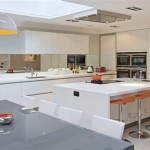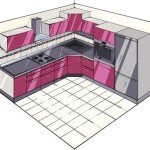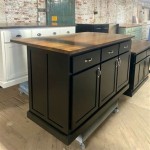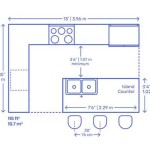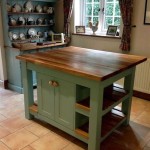Kitchens With Butcher Block Countertops: A Visual and Practical Guide
Butcher block countertops have witnessed a significant resurgence in kitchen design, offering a blend of warmth, functionality, and aesthetic appeal. Their natural beauty, coupled with their practical durability, makes them a compelling choice for homeowners seeking a kitchen surface that is both visually striking and capable of withstanding the rigors of daily use. This article explores the diverse applications of butcher block countertops, focusing on visual examples and practical considerations for incorporating them into modern kitchens.
Butcher block is constructed by fusing together strips of wood, typically hardwoods like maple, walnut, cherry, or oak. These strips are arranged in various patterns, including edge grain, end grain, and face grain, each offering a distinct appearance and level of durability. Edge grain, where the sides of the wood strips are exposed, is a common and more affordable option. End grain, where the ends of the wood strips are visible, is renowned for its resilience and self-healing properties, making it ideal for heavy chopping. Face grain, where the flat surface of the wood is displayed, offers a wider grain pattern but is generally less durable than edge or end grain.
The inherent warmth of wood contrasts beautifully with cooler materials like stainless steel appliances, stone backsplashes, and painted cabinetry. This contrast creates visual interest and depth within the kitchen space, lending a sense of character and sophistication. Furthermore, the natural variations in wood grain and color imbue each butcher block countertop with a unique identity, ensuring that no two kitchens are exactly alike. The following sections will delve into specific design applications and practical considerations when integrating butcher block countertops.
Visual Harmony: Integrating Butcher Block into Diverse Kitchen Styles
The versatility of butcher block allows it to seamlessly integrate into an array of kitchen styles, from rustic farmhouse to sleek modern designs. The key lies in selecting the appropriate wood species, grain orientation, and finishing techniques to complement the overall aesthetic. Consider the following examples:
Farmhouse Kitchens: For a farmhouse kitchen, a thick, end-grain maple butcher block countertop can serve as a central island centerpiece. The robust appearance and natural texture of the wood will perfectly complement shiplap walls, apron-front sinks, and open shelving. A natural oil finish will enhance the wood's inherent warmth and provide a durable, food-safe surface.
Modern Kitchens: In a modern kitchen, a sleek, edge-grain walnut butcher block countertop can provide a sophisticated contrast to minimalist cabinetry and stainless steel appliances. A darker stain or a polyurethane finish can accentuate the wood's rich color and create a seamless transition between the countertop and other elements in the space. Consider using butcher block as an accent on a smaller island or peninsula to break up the expanse of a lighter-colored countertop material like quartz.
Transitional Kitchens: Transitional kitchens, which blend traditional and modern elements, benefit from the warmth and natural beauty of butcher block. Pairing a light-colored, edge-grain maple countertop with painted cabinets in a neutral hue can create a balanced and inviting space. Incorporating elements like subway tile backsplashes and stainless steel hardware will further enhance the transitional aesthetic.
Scandinavian Kitchens: The clean lines and minimalist aesthetic of Scandinavian kitchens are perfectly complemented by the natural simplicity of butcher block. A light-colored, edge-grain birch or maple countertop, finished with a matte oil, will enhance the airy and bright feel of the space. Pairing the butcher block with white cabinetry and concrete flooring will create a cohesive and harmonious design.
These examples demonstrate the adaptable nature of butcher block. Careful consideration of the wood species, grain orientation, and finish allows homeowners to tailor the countertop to their specific design preferences, creating a kitchen that is both functional and visually appealing.
Practical Considerations: Maintenance and Durability
While butcher block countertops offer numerous aesthetic advantages, their longevity and performance depend heavily on proper maintenance. Understanding the material's properties and implementing a consistent care routine is essential for preserving its beauty and functionality.
Regular Cleaning: Butcher block should be cleaned regularly with warm water and a mild soap. Avoid harsh chemicals, abrasive cleaners, and excessive water exposure, as these can damage the wood. After cleaning, thoroughly dry the countertop to prevent water damage and warping.
Oiling and Sealing: Butcher block requires periodic oiling to maintain its moisture content and prevent cracking. Mineral oil or butcher block oil, both food-safe options, should be applied liberally to the surface every few months, or more frequently depending on usage. The oil penetrates the wood, nourishing the fibers and creating a protective barrier against moisture. Sealing the butcher block with a food-safe sealant can provide additional protection against stains and water damage. Reapply sealant according to the manufacturer's instructions.
Preventing Stains and Scratches: While butcher block is naturally resistant to bacteria, it is susceptible to staining from acidic foods and liquids. Wipe up spills promptly to prevent discoloration. Use cutting boards to protect the surface from scratches and cuts. While minor scratches can often be sanded out, deep gouges may require professional repair.
Sanding and Refinishing: Over time, butcher block countertops may develop a patina of scratches and wear. Sanding and refinishing the surface can restore its original beauty and remove any imperfections. Use fine-grit sandpaper to gently sand the countertop, following the grain of the wood. After sanding, apply a fresh coat of oil or sealant to protect the surface.
By adhering to these maintenance practices, homeowners can ensure that their butcher block countertops remain beautiful and functional for many years to come. Regular cleaning, oiling, and preventative measures are essential for preserving the wood's integrity and aesthetic appeal.
Design Applications: Beyond the Standard Countertop
The versatility of butcher block extends beyond traditional countertop applications. Designers are increasingly incorporating it creatively into various kitchen elements, adding warmth and character to the space. Consider these innovative design applications:
Kitchen Islands: A butcher block island countertop can serve as a focal point in the kitchen, providing ample prep space and a welcoming gathering spot. The island can feature a waterfall edge, where the butcher block extends down the sides, creating a seamless and visually striking design. The island can also incorporate built-in storage, such as drawers and shelves, for added functionality.
Open Shelving: Incorporating butcher block as open shelving in the kitchen can add a touch of rustic charm and provide convenient storage for dishes, cookware, and other kitchen essentials. The butcher block shelves can be paired with metal brackets or wooden supports, depending on the desired aesthetic. The shelves can be finished with a natural oil or stain to complement the surrounding cabinetry.
Backsplashes: While less common, butcher block can also be used as a backsplash. This creates a cohesive and visually appealing design, especially when paired with a matching butcher block countertop. However, it's crucial to properly seal and maintain the backsplash to protect it from moisture and grease splatters. Opting for a vertical grain butcher block can help in preventing water pooling. Consider using it behind a sink as a smaller accent.
Breakfast Bars and Peninsulas: A butcher block breakfast bar or peninsula can provide a casual dining space and extend the countertop surface. The butcher block can be cantilevered over existing cabinetry or supported by legs or brackets. This design is ideal for small kitchens where space is limited.
Cutting Boards and Workstations: Incorporating built-in cutting boards or workstations made from butcher block can enhance the functionality of the kitchen. These areas can be seamlessly integrated into the countertop or island, providing a dedicated space for food preparation. The cutting boards can be removable for easy cleaning and maintenance.
These design applications demonstrate the flexibility of butcher block and its ability to enhance the functionality and aesthetic appeal of various kitchen elements. By thinking beyond the traditional countertop, homeowners can create a unique and personalized kitchen space that reflects their individual style and needs. The warm and inviting nature of butcher block makes it a valuable asset in any kitchen design.

Changing The Plans Butcher Block Countertop Inspiration Life With Lavery

Our Butcher Block Counter Top Review One Year Later

Kitchens With Butcher Block Counters Gofoodservice

7 Steps To Installing A Butcher Block Wood Countertop

The Most Important Reasons To Install Butcher Block Counter Tops Town Country Living
:max_bytes(150000):strip_icc()/Simple-modern-shiplap-kithcen-black-59949b62aad52b0011676e5d.jpg?strip=all)
16 Modern Kitchens With Butcher Block Countertops

Installing Butcher Block Countertops Wildfire Interiors

Butcher Block Countertops Buying Guide The Home

Kitchens With Butcher Block Counters Gofoodservice

6 Butcher Block Kitchen Styles Warmth Workability And Value Sweeten

